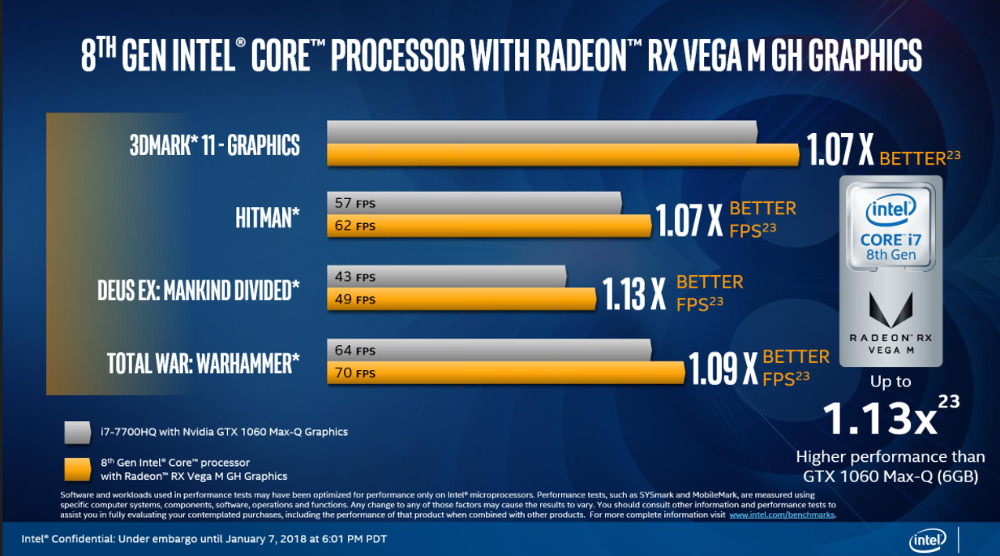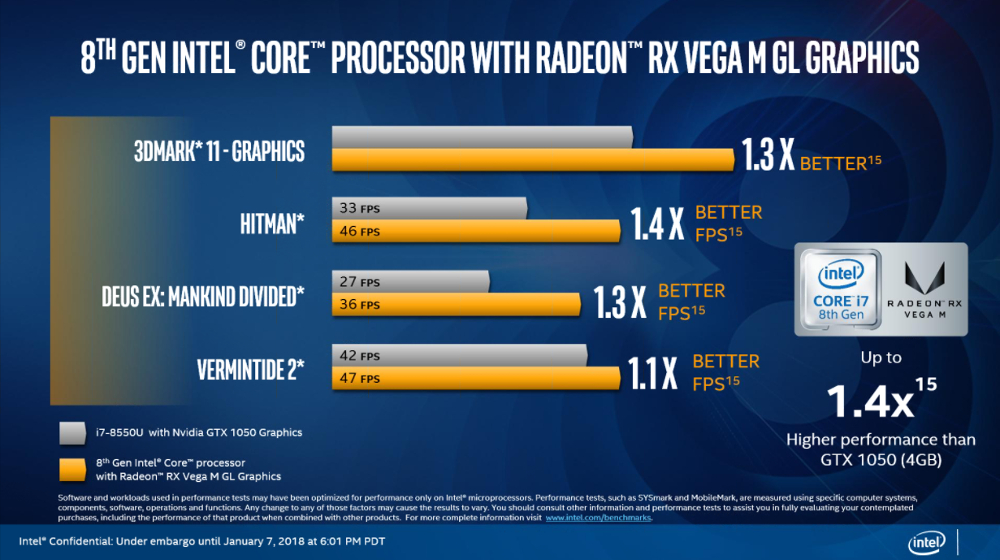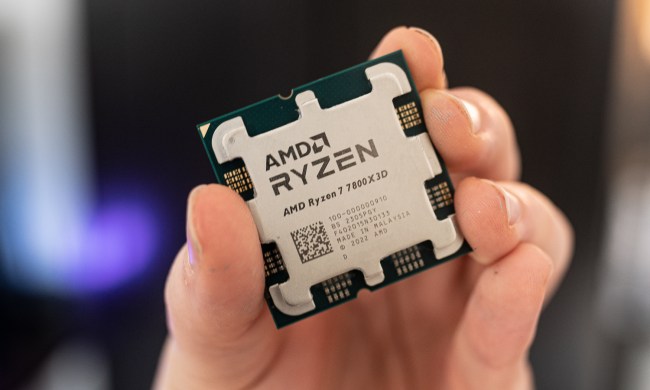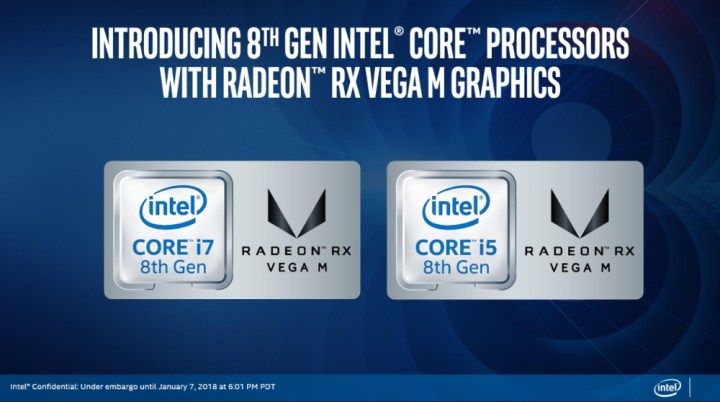
AMD and Intel, sitting in a tree…
The Radeon RX Vega M graphics chip AMD is providing to Intel is “semi-custom” hardware, which means it’s tailoring Vega hardware specifically for Intel’s requirements.
The first shipments will come in two flavors. Intel’s Core-i7 8809G and i7-8709G is the first, which will have GH Graphics with 24 Compute Units. Meanwhile, Intel’s Core i5-8305G and i7-8705G will have the less-powerful GL Graphics, which includes 20 Compute Units. The GL Graphics version also has a slightly lower clock speed and GPU clock.
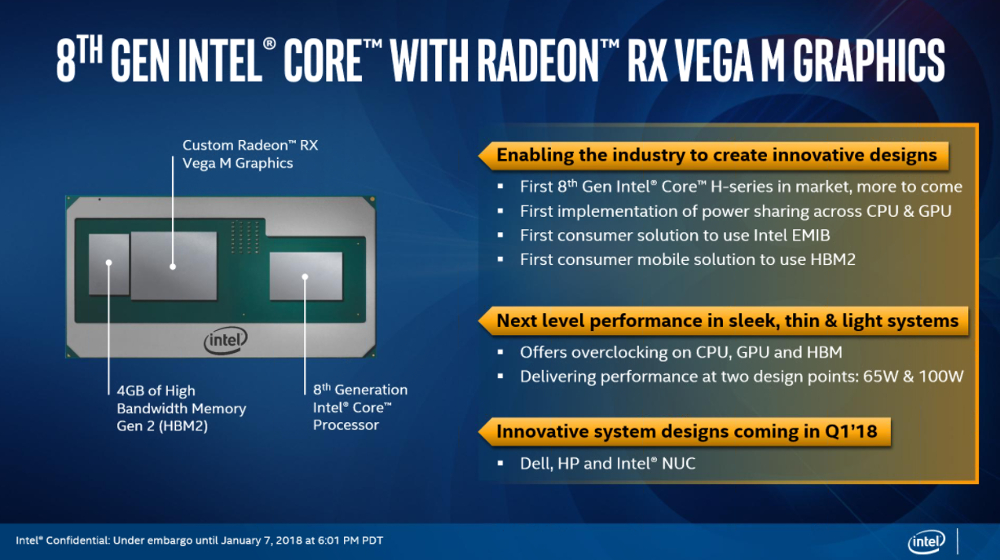
Compute Units and clock speeds are the only major areas of difference, however. The GH and GL models otherwise share many details, including four gigabytes of HBM2 memory. This memory connects to the Vega GPU using a new “embedded multi-die interconnect bridge,” which drastically reduces the amount of physical space required for video memory.
The result is space savings of up to 1,900 square millimeters compared to previous set-ups. Intel says this will help these new chips fit into much slimmer, smaller laptops. Several design wins are promised at CES, though they are currently under embargo by their respective designers.
| Processor | i7-8809G, i7-8709G | i7 8705G, i5-8305G |
| Graphics Version | Radeon RX Vega M GH | Radeon RX Vega M GL |
| Compute Units | 24 | 20 |
| Stream Processsors | 1,536 | 1,280 |
| Base GPU Clock | 1,063MHz | 931MHz |
| Boost GPU Clock | 1,190MHz | 1,011MHz |
| Memory Bandwidth | Up to 3.7 TFLOPs | Up to 2.6 TFLOPs |
| ROPs | 64 pix/clk | 32 pix/clk |
| High Bandwidth Cache | 4GB HBM2 | 4GB HBM2 |
Watch out, Nvidia
What does that mean for performance? Intel says the Radeon RX Vega M GL’s performance is slightly better (between 10 and 40 percent improved) than a Core i7-8550U with GTX 1050 graphics. The games used for this example, as you can see below, include Hitman, Deus Ex: Mankind Divided, and Vermintide 2. It’s also worth note that this comparison involves GL Graphics, the least powerful of the two options.
The more-powerful Radeon RX Vega M GH is even more impressive. Intel says it can go toe-to-toe with the Nvidia GTX 1060 Max-Q in Hitman, Deus Ex: Mankind Divided, and Total War: Warhammer. That’s performance even serious gamers can appreciate. It’s also, of course, a staggering leap above Intel’s UHD graphics, which often struggled to play these titles at an acceptable framerate — even with settings at their lowest presets.
These results, if delivered, are impressive. It suggests that a notebook powered by one of Intel’s new Radeon-powered chips could go toe-to-toe with an entry-level gaming laptop and win. That likely doesn’t mean we’ll see the Intel hardware power a surge of new budget gaming laptops, but it might mean a better baseline of graphics performance from many laptops.
Intel says virtual reality is a target, too, and promises that Intel 8th-gen Core with Radeon RX Vega M will bring VR capability to thinner devices than ever before. Technically, that’s not a claim Intel can back up yet because Oculus and HTC haven’t certified it (with this being brand-new). If performance does stack up to what’s promised, however, VR should be at least possible — if not necessarily ideal.
Would you like all the drivers?
While the hardware inside Intel’s 8th-gen Core with Radeon RX Vega M is intriguing, it’s just half the story. Equally interesting, and important, is the software used. What drivers will be available, and how will you use them?
As it turns out, Intel won’t be putting up arbitrary barriers. PCs built on the new hardware can use features from the AMD chip, Intel’s chip, or both. The chip’s feature list is impressive as a result. It can handle up to nine displays, along with the newest connection standards: Thunderbolt 3, DisplayPort 1.4 w/HDR, and HDMI 2.0b with HDR10 — at up to 4K resolution.
HEVC and H264 HDR encode/decode support is included, and Radeon ReLive can be used to encode/decode multimedia at up to 4K resolution at 60 frames per second. DirectX 12 is supported, of course, but so is the less common Vulkan API. We can’t think of any obvious feature the chip won’t handle, and it’s a huge step forward from Intel’s UHD graphics.
Another feature, referred to as “dynamic power sharing,” will manage the power draw of the CPU and GPU. Intel says the thermal design power target is 65 watts for mobile, and 100 watts for desktop, but that number is not based on full use of both the CPU and GPU portions. Instead, Intel says its software will shift load between, depending on the task at hand.
That will not doubt raise eyebrows among enthusiasts, who generally prefer to see their hardware capable of going all-out instead of relying on opaque software to decide how the hardware is used for them. Yet dynamic power management is hardly new – almost all modern processors do it to some degree. Intel says dynamic power sharing improves power efficiency by up to 18 percent, improving performance in thin-and-light form factors.

You’ll manage all these features through a software interface that’s virtually identical to AMD’s Radeon Adrenalin Edition, which ships with AMD’s Radeon RX Vega video cards. The driver replaces AMD’s logos with Intel’s, however, and the color scheme is shifted from red to blue. Intel itself will distribute driver updates, though those updates will be sourced from AMD. One concern is the possibility of delayed driver releases that put the Intel hardware a few driver versions behind AMD hardware, despite both using the same GPU architecture. Intel hasn’t said how long updates will take to release or how it plans to manage the driver release schedule.
Intel’s own driver software will be present too, which means features like Intel Quick Sync video and Intel XTU will also be available.
You’ll have to settle for a last-gen CPU
The new Vega-based GPU is obviously the star of this show, but what about the processors themselves? Intel says they’ll be based on the Kaby Lake architecture, which is a generation behind the Coffee Lake architecture used in the 8th-gen Intel Core mobile chips that debuted in late 2017.
One feature, however, does standout: Overclocking. The Core i7-8809G will be unlocked, for both the CPU and GPU. That means enthusiasts will have a lot of freedom in tuning its performance. And remember, as mentioned, the chip will run AMD driver software for the Vega GPU, which means you can use AMD’s Wattman utility to fine-tune the chip with ease.
Here’s all the specifications.
| Processor | Core i7-8809G | Core i7-8790G | Core i7-8705G | Core i5-8305G |
| Maximum Clock Speed | 4.2GHz | 4.1GHz | 4.1GHz | 3.8GHz |
| Base Clock Speed | 3.1GHz | 3.1GHz | 3.1GHz | 2.8GHz |
| Cores/Threads | 4/8 | 4/8 | 4/8 | 4/8 |
| Cache Size (MB) | 8 | 8 | 8 | 6 |
| Memory Channels | 2 | 2 | 2 | 2 |
| Memory Type | DDR4-2400 | DDR4-2400 | DDR4-2400 | DDR4-2400 |
| Overclockable? | Yes | No | No | No |
| Discrete Graphics | Radeon RX Vega M GH | Radeon RX Vega M GH | Radeon RX Vega M GL | Radeon RX Vega M GL |
| Intel HD Graphics | UHD 630 | UHD 630 | UHD 630 | UHD 630 |
The chips all have four cores, with eight threads and a maximum clock speed ranging from 3.8GHz to 4.2GHz. It does appear that Intel has managed a small bump to clock speed when compared to similar, older chips. The new Core i7-8705G has a maximum clock of 4.1GHz and base clock of 3.1GHz, while the old Core i7-7700HQ has a maximum clock of 3.8GHz and minimum clock of 2.8GHz.
Intel hasn’t released pricing for these chips, and it wouldn’t be of much use, anyway. These are all BGA packaged, which means they’re soldered onto the motherboard. No plans have been announced for socketed versions of the hardware. That doesn’t mean it’ll never happen, but Intel clearly wants to see these chips show up in laptops and desktops from major manufacturers, not scooped up by enthusiasts building rigs at home.

